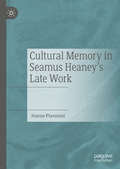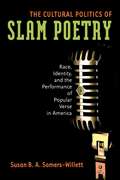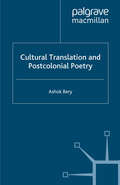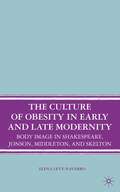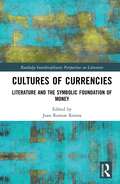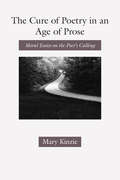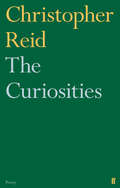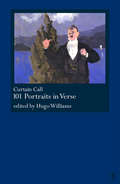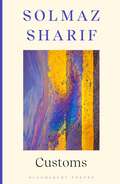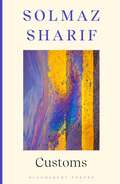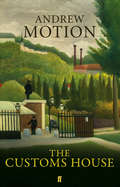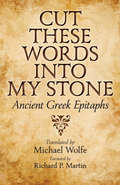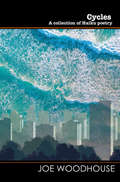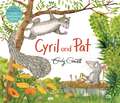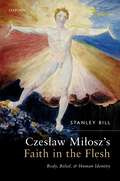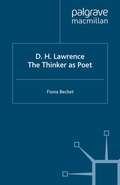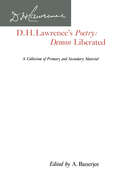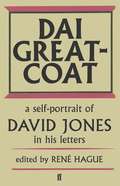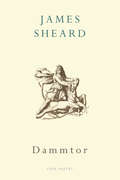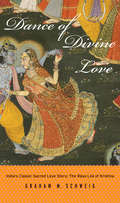- Table View
- List View
Cultural Memory in Seamus Heaney’s Late Work
by Joanne PiavaniniCultural Memory in Seamus Heaney’s Late Work considers the ways that memory functions in Heaney’s poetry. Joanne Piavanini argues that the shaping of collective memory is one of Heaney’s major contributions as a poet. Locating Heaney in a transnational literary sphere, this book argues that his late work isdefined by a type of cosmopolitanism openness: the work moves beyond national identity to explore multiple allegiances and identifications. Moreover, Piavanini demonstrates that memory is a helpful lens to look at Heaney’s late work, in particular, because of the interplay of past, present and future in these works: in the construction of a collective memory of the Troubles; in the use of the elegy to commemorate the passing of important contemporary poets; in his writing on events with transnational significance, such as 9/11; in the slippages between past and present in poems about his family; and through the literary afterlives of texts—specifically, his appropriation of canonical classical texts. Drawing on approaches and concepts from memory studies, Piavanini considers Heaney’s late work to develop an analysis of poetry as a vehicle of memory.
The Cultural Politics of Slam Poetry: Race, Identity, and the Performance of Popular Verse in America (Anthropology series)
by Susan B. Somers-Willett"For a lucid and thorough 'real-world' analysis of the movement from the ground-up--including its history, aesthetics, and culture, there is surely no better place to start than Somers-Willett's trailblazing book." --- Jerome Sala, Pleiades "Finally, a clear, accurate, and thoroughly researched examination of slam poetry, a movement begun in 1984 by a mixed bag of nobody poets in Chicago. At conception, slam poetry espoused universal humanistic ideals and a broad spectrum of participants, and especially welcome is the book's analysis of how commercial marketing forces succeeded in narrowing public perception of slam to the factionalized politics of race and identity. The author's knowledge of American slam at the national level is solid and more authentic than many of the slammers who claim to be." ---Marc Kelly Smith, founder/creator of the International Poetry Slam movement The cultural phenomenon known as slam poetry was born some twenty years ago in white working-class Chicago barrooms. Since then, the raucous competitions have spread internationally, launching a number of annual tournaments, inspiring a generation of young poets, and spawning a commercial empire in which poetry and hip-hop merge. The Cultural Politics of Slam Poetry is the first critical book to take an in-depth look at slam, shedding light on the relationships that slam poets build with their audiences through race and identity performance and revealing how poets come to celebrate (and at times exploit) the politics of difference in American culture. With a special focus on African American poets, Susan B. A. Somers-Willett explores the pros and cons of identity representation in the commercial arena of spoken word poetry and, in doing so, situates slam within a history of verse performance, from blackface minstrelsy to Def Poetry. What's revealed is a race-based dynamic of authenticity lying at the heart of American culture. Rather than being mere reflections of culture, Somers-Willett argues, slams are culture---sites where identities and political values get publicly refigured and exchanged between poets and audiences. Susan B. A. Somers-Willett is a decade-long veteran of slam and teaches creative writing and poetics as an Assistant Professor of English at Montclair State University. She is the author of two books of poetry, Quiver and Roam. Visit the author's website at: http://www.susansw.com/. Photo by Jennifer Lacy.
Cultural Translation and Postcolonial Poetry
by A. BeryThis book uses the framework of cultural translation to explore the work of six significant modern writers from Ireland, India, Australia and the Caribbean. Written in an accessible and approachable style, it will be of interest not only to specialists in postcolonial literatures, but also readers of modern and contemporary poetry more generally.
The Culture of Obesity in Early and Late Modernity: Body Image in Shakespeare, Jonson, Middleton, and Skelton
by E. Levy-NavarroThis book offers the first sustained examination of fatness in the early modern period. Using readings of such major figures as Shakespeare, Jonson, Middleton, and Skelton, this book considers alternative ways that fat was constructed before the introduction of the modern pathologized category of 'obesity'.
Cultures of Currencies: Literature and the Symbolic Foundation of Money (Routledge Interdisciplinary Perspectives on Literature)
by Joan Ramon ResinaThis book’s premise is not only the commonly accepted cultural relativity of economic concepts, but also the observation that the current shift in the meaning of concepts like “market,” “currency,” “exchange,” and “money” suggests that culture is undergoing a change with unpredictable economic and political consequences. The essays in the book raise basic questions concerning exchange – what is exchanged, who exchanges and how, which kind of currency is used, and indeed what is money and how does it convey and retain value over time. These issues are all classical objects of economic theory, but less often have they been approached from a cultural perspective. Works treating economic and monetary issues from a cultural perspective are few and far apart, and this book aims to contribute to such a perspective with a variety of approaches.
Cultures of Currencies: Literature and the Symbolic Foundation of Money (Routledge Interdisciplinary Perspectives on Literature)
by Joan Ramon ResinaThis book’s premise is not only the commonly accepted cultural relativity of economic concepts, but also the observation that the current shift in the meaning of concepts like “market,” “currency,” “exchange,” and “money” suggests that culture is undergoing a change with unpredictable economic and political consequences. The essays in the book raise basic questions concerning exchange – what is exchanged, who exchanges and how, which kind of currency is used, and indeed what is money and how does it convey and retain value over time. These issues are all classical objects of economic theory, but less often have they been approached from a cultural perspective. Works treating economic and monetary issues from a cultural perspective are few and far apart, and this book aims to contribute to such a perspective with a variety of approaches.
The Cure of Poetry in an Age of Prose: Moral Essays on the Poet's Calling
by Mary KinzieThe role of the poet, Mary Kinzie writes, is to engage the most profound subjects with the utmost in expressive clarity. The role of the critic is to follow the poet, word for word, into the arena where the creative struggle occurs. How this mutual purpose is served, ideally and practically, is the subject of this bracingly polemical collection of essays. A distinguished poet and critic, Kinzie assesses poetry's situation during the past twenty-five years. Ours, she contends, is literally a prosaic age, not only in the popularity of prose genres but in the resultant compromises with truth and elegance in literature. In essays on "the rhapsodic fallacy," confessionalism, and the romance of perceptual response, Kinzie diagnoses some of the trends that diminish the poet's flexibility. Conversely, she also considers individual poets—Randall Jarrell, Elizabeth Bishop, Howard Nemerov, Seamus Heaney, and John Ashbery—who have found ingenious ways of averting the risks of prosaism and preserving the special character of poetry. Focusing on poet Louise Bogan and novelist J. M. Coetzee, Kinzie identifies a crucial and curative overlap between the practices of great prose-writing and great poetry. In conclusion, she suggests a new approach for teaching writers of poetry and fiction. Forcefully argued, these essays will be widely read and debated among critics and poets alike.
The Curiosities
by Christopher ReidThe Curiosities is the eleventh book of poems from this most inventive and celebrated of British poets. Clustering around the letter 'C', the seventy-some poems that comprise this collection celebrate a lexicon of lived experience through a single letter of the alphabet. Here we find tales of cufflinks and costume, cougars and cochineal, catapults and cavalry, even canoodlings in canoes. With a characteristic sleight of hand, Christopher Reid shifts deftly between seriousness and play, elegy and anarchy in this sometimes-zany, sometimes-haunting compendium of bright-eyed verses. Here and there the story-telling roams and sweeps: here are tales 'for' friends and loved ones, there are tales 'after' the great poets of history. But whoever and whatever the mode of address, these poems are frequently underpinned by a unifying humanity. The Curiosities is a temptatious read, full of wisdom and surprise, humour and lament, and is a poignant and convincing reminder that in a world where 'nobody's allowed to live forever', life is for celebrating, and grasping by the collar.
Curtain Call: 101 Portraits in Verse
by Hugo WilliamsThe art of portraiture in poetry is traceable from the Latin poets and Chaucer via Goldsmith, Wordsworth and Browning, to the modern era of Rimbaud, Cavafy, Auden, Lowell and Hofmann. Poetry is an art form which encourages introspection, so it is a welcome break to find these poets looking outward, fondly or otherwise, in homage or in satire, at their fellow performers on the human stage. Here, you may find yourself rubbing shoulders with the likes of Elvis Presley, Oscar Wilde, and the Duke of Buckingham, or buttonholed by intriguing gatecrashers to the virtual party. Who is Butch Weldy, for instance? And what did become of Waring?
Customs
by Solmaz SharifLonglisted for the 2023 PEN/Jean Stein Book AwardLonglisted for the 2022 Brooklyn Public Library Book PrizeA New Yorker Essential Read of 2022A Publishers Weekly Best Book of 2022An NPR Best Book of 2022A Literary Hub Best Reviewed Poetry Collection of 2022_______________'Witty and incisive… [Sharif] masterfully traverses the landscape of exile and all its complicated grief' New York Times_______________The devastating second collection by Solmaz Sharif, author of Look, a National Book Award finalistWith Customs, Solmaz Sharif offers a series of poetic refusals, weighing nuanced questions about what it means to belong to a place. In the face of hard borders these poems seek a reckoning with the structures, in society, in language itself, by which these limits act on us.Sharif examines what it means to exist in the nowhere of the arrivals terminal; to navigate a continual series of checkpoints, officers, searches, and questionings that can become a relentless challenge; a mutating shibboleth. Through the poet's adept balancing of tonal and formal elements, these poems interrogate the 'customs' of the nation-state, of the English language, of the paces these systems put us through. But this work is not enjoined to a hopeless quest. Instead, the propulsive force that informs each line, each white space, and punctuation mark, is a powerfully galvanizing and healing force.Customs reminds us of the generative possibilities of restlessness, of seeking in each poem to refresh what it is a poem can be and do.
Customs
by Solmaz SharifLonglisted for the 2023 PEN/Jean Stein Book AwardLonglisted for the 2022 Brooklyn Public Library Book PrizeA New Yorker Essential Read of 2022A Publishers Weekly Best Book of 2022An NPR Best Book of 2022A Literary Hub Best Reviewed Poetry Collection of 2022_______________'Witty and incisive… [Sharif] masterfully traverses the landscape of exile and all its complicated grief' New York Times_______________The devastating second collection by Solmaz Sharif, author of Look, a National Book Award finalistWith Customs, Solmaz Sharif offers a series of poetic refusals, weighing nuanced questions about what it means to belong to a place. In the face of hard borders these poems seek a reckoning with the structures, in society, in language itself, by which these limits act on us.Sharif examines what it means to exist in the nowhere of the arrivals terminal; to navigate a continual series of checkpoints, officers, searches, and questionings that can become a relentless challenge; a mutating shibboleth. Through the poet's adept balancing of tonal and formal elements, these poems interrogate the 'customs' of the nation-state, of the English language, of the paces these systems put us through. But this work is not enjoined to a hopeless quest. Instead, the propulsive force that informs each line, each white space, and punctuation mark, is a powerfully galvanizing and healing force.Customs reminds us of the generative possibilities of restlessness, of seeking in each poem to refresh what it is a poem can be and do.
The Customs House
by Sir Andrew MotionAndrew Motion's new book opens with a sequence of war poems (first published as the pamphlet Laurels and Donkeys, on Armistice Day 2010), drawing on soldiers' experiences of war from 1914 until today - beginning with a story about Siegfried Sassoon and moving via World War Two and Korea to the recent conflicts in Iraq and Afghanistan. Many of the poems are in the voices of combatants, others are based on memories of the poet's father, who landed at D-day and fought in France and Germany. The poems combine understatement with a clear-eyed and unswerving candour.The Customs House has other rooms: a group of topographies, mapping moments in a marriage against the contingencies of place and family history; and several 'found poems', in which the poet collaborates with his source, mixing what is there already with what is about to be there: whether a remarkable sonnet sequence on the last days of the Baroque genius Francesco Borromini, or in other poems a richly imagined extrapolation from the silent premises of a painting.
Cut These Words into My Stone: Ancient Greek Epitaphs
by Richard P. MartinCut These Words into My Stone offers evidence that ancient Greek life was not only celebrated in great heroic epics, but was also commemorated in hundreds of artfully composed verse epitaphs. They have been preserved in anthologies and gleaned from weathered headstones.Three-year-old Archianax, playing near a well,Was drawn down by his own silent reflection.His mother, afraid he had no breath left,Hauled him back up wringing wet. He had a little.He didn't taint the nymphs' deep home.He dozed off in her lap. He's sleeping still.These words, translated from the original Greek by poet and filmmaker Michael Wolfe, mark the passing of a child who died roughly 2,000 years ago. Ancient Greek epitaphs honor the lives, and often describe the deaths, of a rich cross section of Greek society, including people of all ages and classes— paupers, fishermen, tyrants, virgins, drunks, foot soldiers, generals—and some non-people—horses, dolphins, and insects. With brief commentary and notes, this bilingual collection of 127 short, witty, and often tender epigrams spans 1,000 years of the written word. Cut These Words into My Stone provides an engaging introduction to this corner of classical literature that continues to speak eloquently in our time.
Cut These Words into My Stone: Ancient Greek Epitaphs
by Michael Wolfe Richard P. MartinCut These Words into My Stone offers evidence that ancient Greek life was not only celebrated in great heroic epics, but was also commemorated in hundreds of artfully composed verse epitaphs. They have been preserved in anthologies and gleaned from weathered headstones.Three-year-old Archianax, playing near a well,Was drawn down by his own silent reflection.His mother, afraid he had no breath left,Hauled him back up wringing wet. He had a little.He didn't taint the nymphs' deep home.He dozed off in her lap. He's sleeping still.These words, translated from the original Greek by poet and filmmaker Michael Wolfe, mark the passing of a child who died roughly 2,000 years ago. Ancient Greek epitaphs honor the lives, and often describe the deaths, of a rich cross section of Greek society, including people of all ages and classes— paupers, fishermen, tyrants, virgins, drunks, foot soldiers, generals—and some non-people—horses, dolphins, and insects. With brief commentary and notes, this bilingual collection of 127 short, witty, and often tender epigrams spans 1,000 years of the written word. Cut These Words into My Stone provides an engaging introduction to this corner of classical literature that continues to speak eloquently in our time.
Cutting the Clouds Towards
by Matt SimpsonThe poems in this fifth collection of his poetry were written before, during and after Matt Simpson’s two-month period as poet-in-residence at the Queen Victoria Museum and Art Gallery in Launceston, Tasmania. Most of the poems are responses to encounters with the work and life of the mid-nineteenth-century writer and artist, Louisa Anne Meredith, who spent the first part of her life in Birmingham and who was already established as author and artist before, at the age of twenty-seven, she married her cousin, Charles, and emigrated to Australia. The Merediths were subsequently to spend most of the rest of their lives in Tasmania. Simpson follows Mrs Meredith there, creating an imaginative relationship with her and in his poetry (in the words of John Lucas in his Foreword to this book) ‘exploring in different ways his sense of engagement with a person, a place, and, more remarkably, of hers and it with him. For among the most astonishing features of this intensely creative engagement is the way Mrs Meredith herself emerges as a full and complex character, witty, resilient, keenly observant, even able to rebuke the poet for his “arrogance of hindsight”. At the same time, Matt Simpson engages with the familiar theme in his previous work, now a personal quest of following his seafaring father to the other side of the world. All those who know Simpson’s poems will see this as a continuation and some sort of resolution of what much of his work has been concerned with to date. He completes a sort of odyssey though his arrival in Tasmania, a journey which began many years earlier with his father’s tales of Tasmania. John Lucas again: ‘It takes a rare poet to risk weaving into his own work moments from and allusions to The Tempest, that most authoritative and mysterious of plays, but his poems triumphantly surmount that danger. That they should do so helps us to recognise how assured and compelling is Matt Simpson’s achievement.’
Cycles: A collection of Haiku poetry (Wordcatcher Modern Poetry)
by Joe WoodhouseCycles, Joe Woodhouse’s first collection of Haiku poetry, explores a journey through two contrasting landscapes: the City and the Sea. Chronicling an emigration from Wales to London, and on to the vibrant Spanish coastal town of Sitges, these poems capture micro-moments in nature that amplify and interrogate the thoughts, sensations, feelings and emotions of the ever-fluctuating human condition as one makes their way through the cycles of life.
Cyril and Pat
by Emily GravettCyril and Pat is a very funny, rhyming romp through the park from the CILIP Kate Greenaway Medal-winning Emily Gravett, author of Tidy and Meerkat Mail.'Enormous fun to read aloud.' – GuardianCyril is the only squirrel in Lake Park, and he's very lonely. Until one day he meets Pat – Pat the big, grey . . . other squirrel. Cyril and Pat have lots of adventures and fun together and Cyril is so pleased he's made a friend. But everyone says that Cyril and Pat simply cannot be friends, and they soon reveal why: Pat, as the reader has known all along, is actually a RAT!But Cyril's life turns out to be a lot duller and quite a bit scarier without Pat by his side, and in the end the two friends learn that some things are more important than being the same, or listening to others.
Czesław Miłosz's Faith in the Flesh: Body, Belief, and Human Identity
by Stanley BillThis book presents Czesław Miłosz's poetic philosophy of the body as an original defense of religious faith, transcendence, and the value of the human individual against what he viewed as dangerous modern forms of materialism. The Polish Nobel laureate saw the reductive "biologization" of human life as a root cause of the historical tragedies he had witnessed under Nazi German and Soviet regimes in twentieth-century Central and Eastern Europe. The book argues that his response was not merely to reconstitute spiritual or ideal forms of human identity, which no longer seemed plausible. Instead, he aimed to revalidate the flesh, elaborating his own non-reductive understandings of the self on the basis of the body's deeper meanings. Within the framework of a hesitant Christian faith, Miłosz's poetry and prose often suggest a paradoxical striving toward transcendence precisely through sensual experience. Yet his perspectives on bodily existence are not exclusively affirmative. The book traces his diverse representations of the body from dualist visions that demonize the flesh through to positive images of the body as the source of religious experience, the self, and his own creative faculty. It also examines the complex relations between "masculine" and "feminine" bodies or forms of subjectivity, as Miłosz represents them. Finally, it elucidates his contention that poetry is the best vehicle for conveying these contradictions, because it also combines "disembodied", symbolic meanings with the sensual meanings of sound and rhythm. For Miłosz, the double nature of poetic meaning reflects the fused duality of the human self.
Czesław Miłosz's Faith in the Flesh: Body, Belief, and Human Identity
by Stanley BillThis book presents Czesław Miłosz's poetic philosophy of the body as an original defense of religious faith, transcendence, and the value of the human individual against what he viewed as dangerous modern forms of materialism. The Polish Nobel laureate saw the reductive "biologization" of human life as a root cause of the historical tragedies he had witnessed under Nazi German and Soviet regimes in twentieth-century Central and Eastern Europe. The book argues that his response was not merely to reconstitute spiritual or ideal forms of human identity, which no longer seemed plausible. Instead, he aimed to revalidate the flesh, elaborating his own non-reductive understandings of the self on the basis of the body's deeper meanings. Within the framework of a hesitant Christian faith, Miłosz's poetry and prose often suggest a paradoxical striving toward transcendence precisely through sensual experience. Yet his perspectives on bodily existence are not exclusively affirmative. The book traces his diverse representations of the body from dualist visions that demonize the flesh through to positive images of the body as the source of religious experience, the self, and his own creative faculty. It also examines the complex relations between "masculine" and "feminine" bodies or forms of subjectivity, as Miłosz represents them. Finally, it elucidates his contention that poetry is the best vehicle for conveying these contradictions, because it also combines "disembodied", symbolic meanings with the sensual meanings of sound and rhythm. For Miłosz, the double nature of poetic meaning reflects the fused duality of the human self.
D.H. Lawrence: The Thinker As Poet
by F. BecketD.H. Lawrence: The Thinker as Poet addresses a particular body of language and thought within Lawrence's oeuvre where the metaphorical, the poetic and the philosophical are intricately enmeshed. Lawrence emerges as a writer who pulls metaphor away from its merely rhetorical moorings: his distinctive style is the hallmark of one who thinks not analytically but poetically, about the birth of the self, the body unconscious, complex kinds of otherness and about metaphor itself as a mode of understanding.
D.H.Lawrence's Poetry: Demon Liberated
by Amitava BanerjeeThis book brings together articles and essays published over a period of about 60 years. These discussions lead to an assessment of Lawrence's poetry, showing how he has been regarded as a poet over the years, as well as analyzing the intrinsic merit of his poetry.
Dafydd ap Gwilym (Llên y LLenor)
by R. Geraint GruffyddA critical study of the life and work of Dafydd ap Gwilym, a seminal 14th-century Welsh poet.
Dai Greatcoat: A Self-Portrait of David Jones in his Letters
by David JonesThrough a selection of letters to friends and literary peers, Dai Greatcoat presents a rare insight into the life of the poet and artist David Jones and in so doing offers an autobiographical portrait of the author in his own words.
Dammtor
by James SheardDammtor is the old city gate and now the centre of ground transport for the great port of Hamburg. In James Sheard's second collection it is a 'station for midnights, hitched up on stone legs, hollow with sunken light' - a hub for the damaged and deracinated. These precise, wounded poems draw the reader through this desolate landscape - through sexual longing, sexual violence, bereavement and the beginning of hope through the birth of a son.Dammtor restlessly narrates the condition of maleness, looking for truth and music in a voice which is both urgent and unadorned. The poems are spoken in solitary places - late-night stations, hotel lobbies, car rides and empty woodland - but they are addressed to the living, the missing, the dead and the just-born. Personal and political narratives leak into the spaces of the poems to form a strange light which has something of the hallucinatory clarity of translations. The voice might be by turn elegaic, vicious, obsessive or bewildered as it explores its topic, but it is accompanied by an eye which will not - or, perhaps, cannot - blink. Finding tenderness amid brutality, Dammtor is a highly accomplished and remarkable collection.
Dance of Divine Love: India's Classic Sacred Love Story: The Rasa Lila of Krishna
by Graham SchweigThe heart of this book is a dramatic love poem, the Rasa Lila, which is the ultimate focal point of one of the most treasured Sanskrit texts of India, the Bhagavata Purana. Judged a literary masterpiece by Indian and Western scholars alike, this work of poetic genius and soaring religious vision is one of the world's greatest sacred love stories and, as Graham Schweig clearly demonstrates, should be regarded as India's Song of Songs. The story presents the supreme deity as the youthful and amorous cowherd, Krishna, who joins his beloved maidens in an enchanting and celebratory "dance of divine love." Schweig introduces this work of exquisite poetry and profound theology to the Western world in the form of a luminous translation and erudite scholarly treatment. His book explores the historical context and literary genre of the work and elucidates the aesthetic and emotional richness of the composition, highlighting poignant details of this drama of divine love. Schweig illuminates the religious dimensions and ethical nuances of the drama, drawing widely from the commentaries and esoteric vision of masters of the Caitanya school of Vaishnavism, a prominent devotional Hindu tradition. Themes such as transcendence of death through love, the yoga of devotion, the contrast between worldly love and passionate love for God, and the dialectical tension between ethical boundaries and boundless love are presented. The final event of the Rasa dance, the author concludes, presents a dynamic symbol of supreme love that provides the basis for a theological vision of genuine religious pluralism.
